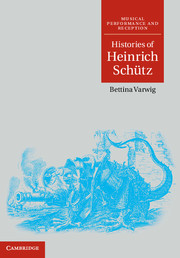Book contents
- Frontmatter
- Contents
- Abbreviations
- Music examples
- Figures
- Acknowledgments
- Introduction
- Chapter One Trumpets and drums (Psalmen Davids, 1617)
- Chapter Two Echoes, mirrors and masks (Dafne, 1627)
- Chapter Three Life, death and afterlife (Musicalische Exequien, 1636)
- Chapter Four Old and new worlds (Geistliche Chor-Music, 1648)
- Conclusion
- Chronology
- Bibliography
- Index
Chapter Four - Old and new worlds (Geistliche Chor-Music, 1648)
Published online by Cambridge University Press: 05 November 2011
- Frontmatter
- Contents
- Abbreviations
- Music examples
- Figures
- Acknowledgments
- Introduction
- Chapter One Trumpets and drums (Psalmen Davids, 1617)
- Chapter Two Echoes, mirrors and masks (Dafne, 1627)
- Chapter Three Life, death and afterlife (Musicalische Exequien, 1636)
- Chapter Four Old and new worlds (Geistliche Chor-Music, 1648)
- Conclusion
- Chronology
- Bibliography
- Index
Summary
Although 1648 is usually cited as the year in which the Thirty Years War ended, in many German territories peace did not arrive there and then. The treaties of Westphalia, signed in Osnabrück and Münster on or before 24 October 1648, brought most military campaigns to a halt, and a clutch of celebratory publications appeared. Yet it was almost another two years before the ‘Recess Concerning the Execution of the Peace’ was concluded in Nuremberg on 26 June 1650, which regulated the withdrawal of foreign troops from the Empire. Large-scale peace celebrations were therefore mostly delayed: in Weimar a thanksgiving service was held on 19 August 1650, in Hamburg on 5 September, and in electoral Saxony on 22 July. The peace negotiations had been dragging on since at least 1643, with uncertain outcome, and their conclusion was therefore widely met with incredulity: in a book of emblems of 1649, Johann Vogel compared the agreement to the biblical camel passing through a needle's eye. Moreover, although a ceasefire between Saxony and Sweden in 1645 had raised the prospect of peace, many areas had stayed under occupation; previous settlements, too, such as the 1635 Peace of Prague between Saxon and Imperial forces, had failed to bring lasting calm. After the 1648 agreement, the ‘three rods’ with which God had been chastising the Germans for the past thirty years – war, hunger, pestilence – continued to strike. The destruction of towns and countryside and resulting supply shortages had long-lasting effects, and plague epidemics presented a constant threat; in Dresden, the majority of people who died during the war had been lost to the disease. Troops remained a burdensome presence, with the gradual dissolution of mercenary armies exacerbating rather than easing social problems.
To many contemporaries, the 1648 peace therefore did not register as much of a new beginning. Although it was marked with a festive ‘Te Deum’ in Saxony's churches, a prayer for the occasion still pleaded for the German lands to ‘really be granted full enjoyment of the beloved peace’. Only with the 1650 agreement did this wish become reality, ushering in a general mood of elation. For the peace festival on 22 July, an allegorical play by the Saxon pastor Johann Feinler – involving all the greats of Greek mythology – proclaimed: ‘We are as if in a dream’ (a quote from Psalm 126); the closing song rejoiced that ‘[God] now brings joy to the destitute country, so that it is renewing itself like an eagle’, drawing on a scriptural image (Ps. 103:5) that had also appeared among Vogel's emblems (Figure 4.1). As a metaphor for the ‘unclothing of the old mankind and re-clothing of the new’, it depicted a bird of prey shedding its plumage as it flies towards the sun. A broadsheet entitled ‘Lang-verlangte Friedens-Freude’ (Long-desired joy of peace) similarly envisaged the dawn of a new era, with Dresden shining on the horizon as a New Jerusalem (Figure 4.2).
- Type
- Chapter
- Information
- Histories of Heinrich Schütz , pp. 161 - 212Publisher: Cambridge University PressPrint publication year: 2011

